380 Ballistics Tables From All The Major Ammunition Manufacturers
Congrats! You’ve discovered our in-depth look at 380 ballistics from many top ammo manufacturers.
You can save time by clicking the links below to jump to your preferred ammo company and find the 380 ACP ballistics data you need for your favorite factory load.
380 Ballistics Charts
Jump to an ammo company: Aguila | Ammo Inc. | Barnes | Blazer Brass | Corbon | Federal | Fiocchi | Hornady | MaxxTech | PMC | Prvi Partizan (PPU) | Remington | Sellier & Bellot | Speer | Winchester
Aguila Ammunition Ballistics - 380 ACP
Aguila 380 ACP 95 grain FMJ Ballistics Chart
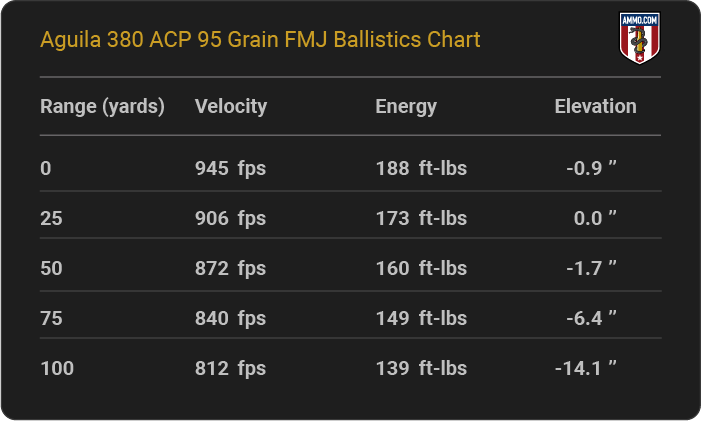
Ammo Inc. Ammunition Ballistics - 380 ACP
Jump to a ballistics chart: Ammo Inc. 380 ACP 100 grain TMJ | Ammo Inc. Streak 380 ACP 100 grain TMJ Non-Incendiary Tracer
Ammo Inc. 380 ACP 100 grain TMJ Ballistics Chart
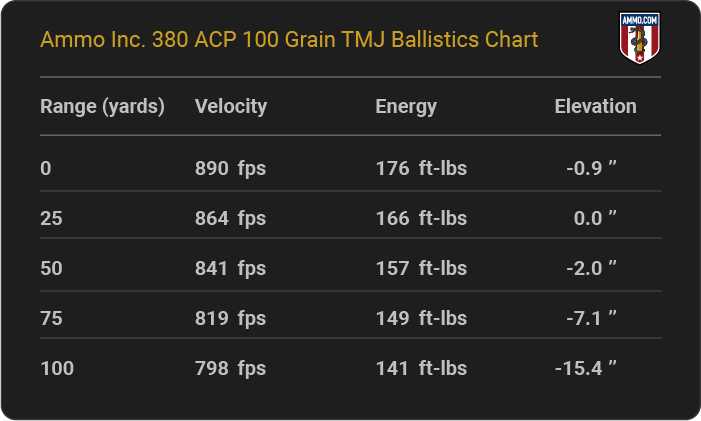
Ammo Inc. Streak 380 ACP 100 grain TMJ Non-Incendiary Tracer Ballistics Chart
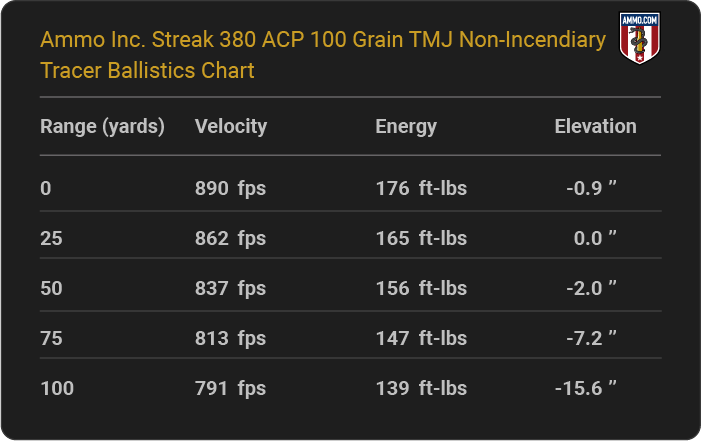
Barnes Ammunition Ballistics - 380 ACP
Barnes 380 ACP 80 grain TAC-XP HP Ballistics Chart
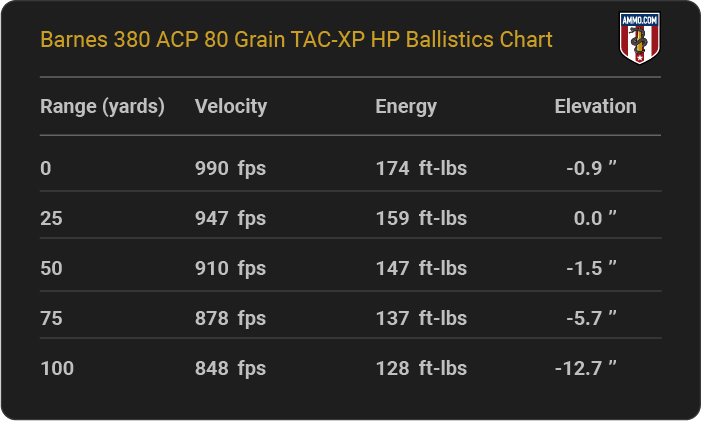
Blazer Brass Ammunition Ballistics - 380 ACP
Blazer Brass 380 ACP 95 grain FMJ Ballistics Chart
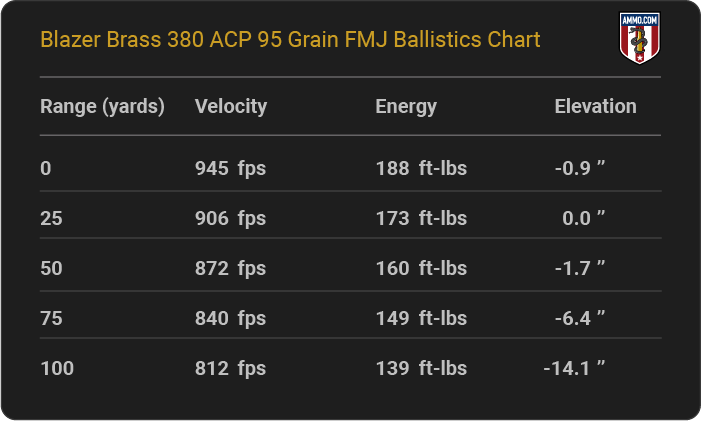
Corbon Ammunition Ballistics - 380 ACP
Jump to a ballistics chart: Corbon 380 ACP 70 grain Pow'RBall | Corbon 380 ACP 80 grain JHP | Corbon 380 ACP 90 grain JHP
Corbon 380 ACP 70 grain Pow'RBall Ballistics Chart
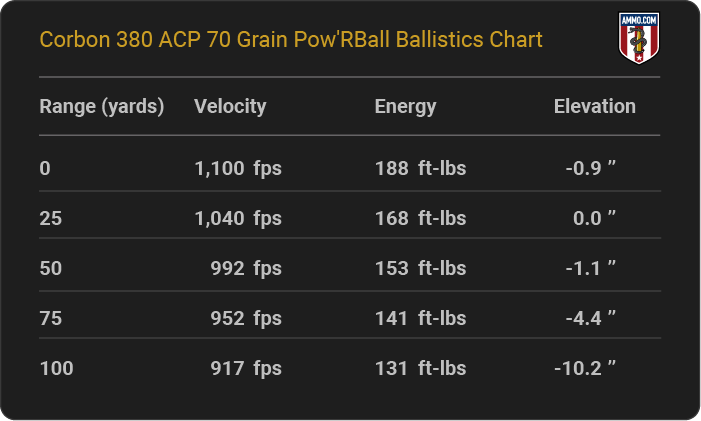
Corbon 380 ACP 80 grain JHP Ballistics Chart

Corbon 380 ACP 90 grain JHP Ballistics Chart
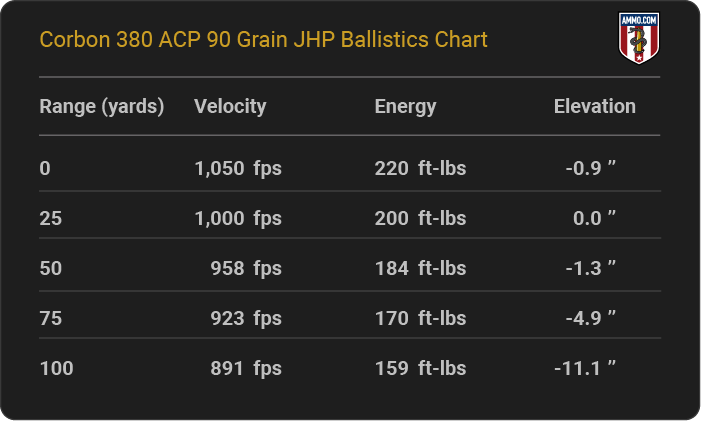
Federal Ammunition Ballistics - 380 ACP
Jump to a ballistics chart: Federal American Eagle 380 ACP 70 grain Indoor Range Training Lead-Free | Federal American Eagle 380 ACP 95 grain FMJ | Federal Personal Defense HST Micro 380 ACP 99 grain JHP | Federal Personal Defense Hydra-Shok Deep 380 ACP 99 grain JHP | Federal Personal Defense Hydra-Shok Low Recoil 380 ACP 90 grain JHP | Federal Personal Defense Punch 380 ACP 85 grain JHP | Federal Train + Protect 380 ACP 85 grain Versatile HP
Federal American Eagle 380 ACP 70 grain Indoor Range Training Lead-Free Ballistics Chart
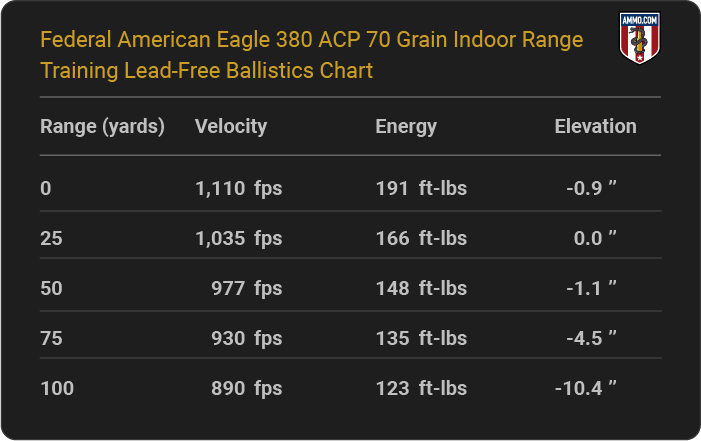
Federal American Eagle 380 ACP 95 grain FMJ Ballistics Chart

Federal Personal Defense HST Micro 380 ACP 99 grain JHP Ballistics Chart

Federal Personal Defense Hydra-Shok Deep 380 ACP 99 grain JHP Ballistics Chart
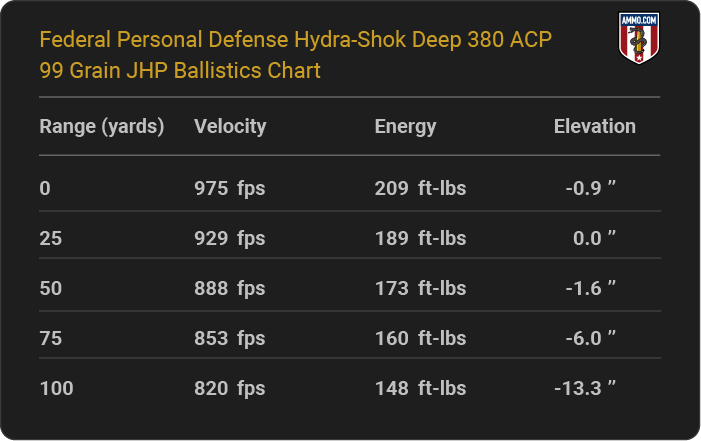
Federal Personal Defense Hydra-Shok Low Recoil 380 ACP 90 grain JHP Ballistics Chart
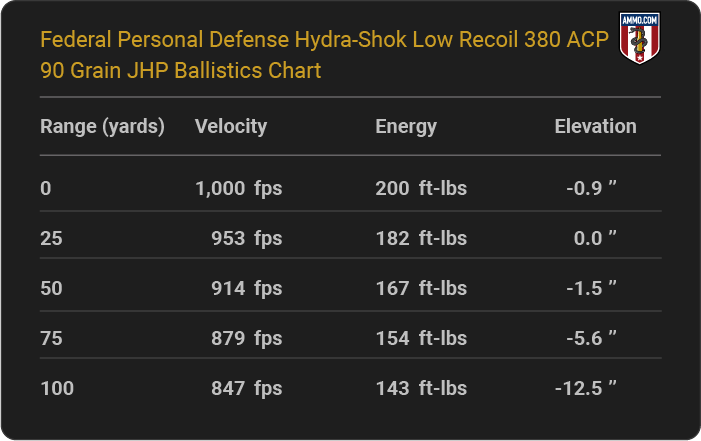
Federal Personal Defense Punch 380 ACP 85 grain JHP Ballistics Chart
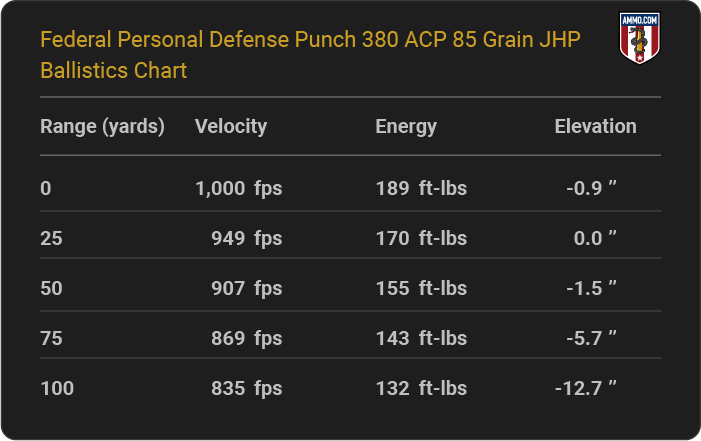
Federal Train + Protect 380 ACP 85 grain Versatile HP Ballistics Chart
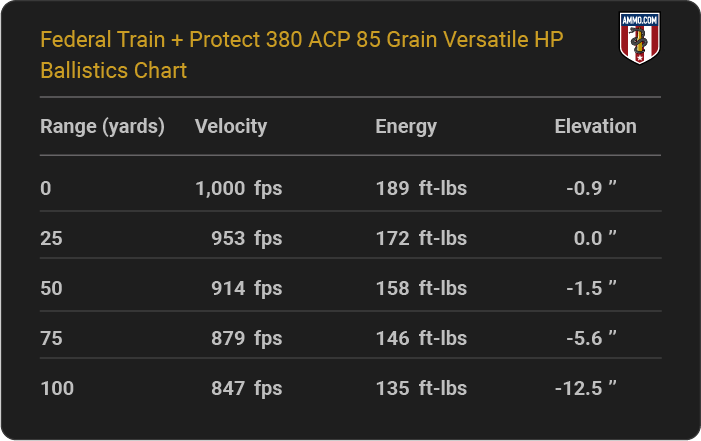
Fiocchi Ammunition Ballistics - 380 ACP
Jump to a ballistics chart: Fiocchi Defense Dynamics 380 ACP 90 grain JHP | Fiocchi Hyperformance Defense 380 ACP 90 grain XTPHP | Fiocchi Range Dynamics 380 ACP 95 grain FMJ
Fiocchi Defense Dynamics 380 ACP 90 grain JHP Ballistics Chart

Fiocchi Hyperformance Defense 380 ACP 90 grain XTPHP Ballistics Chart
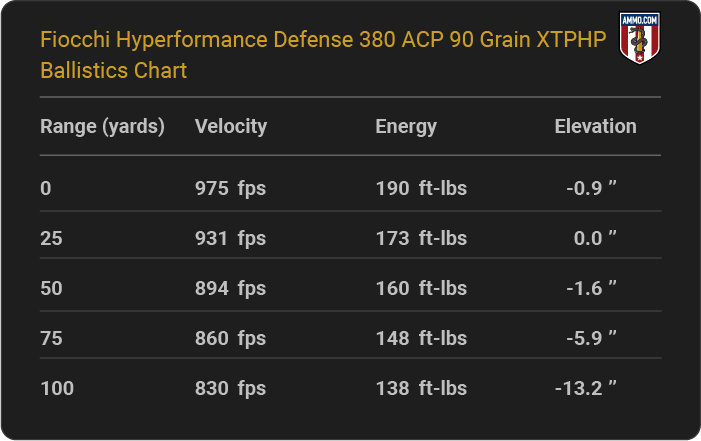
Fiocchi Range Dynamics 380 ACP 95 grain FMJ Ballistics Chart
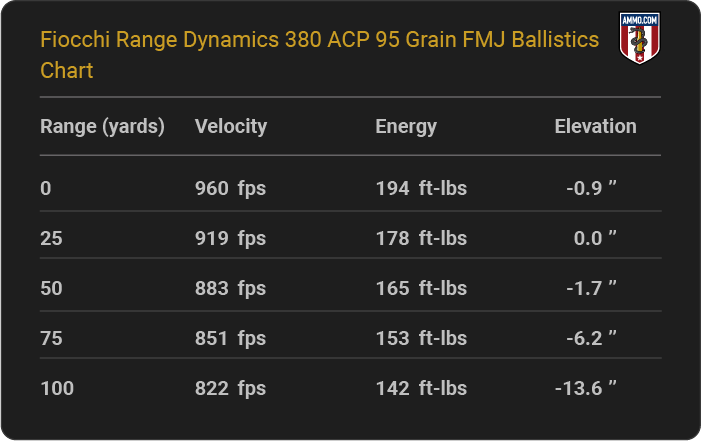
Hornady Ammunition Ballistics - 380 ACP
Jump to a ballistics chart: Hornady American Gunner 380 ACP 90 grain XTP | Hornady Black 380 ACP 90 grain XTP | Hornady Critical Defense 380 ACP 90 grain FTX
Hornady American Gunner 380 ACP 90 grain XTP Ballistics Chart
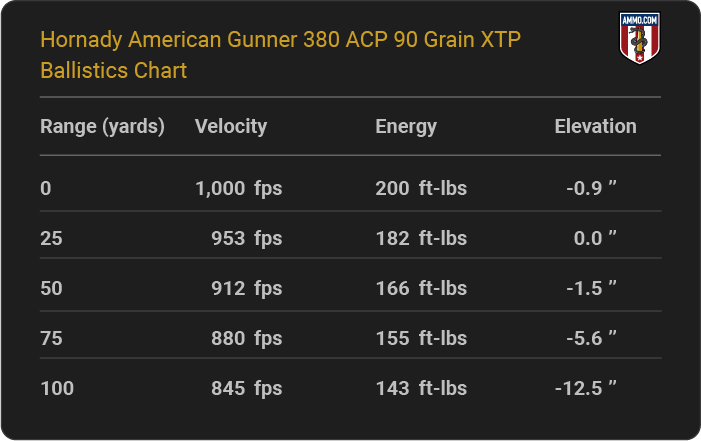
Hornady Black 380 ACP 90 grain XTP Ballistics Chart
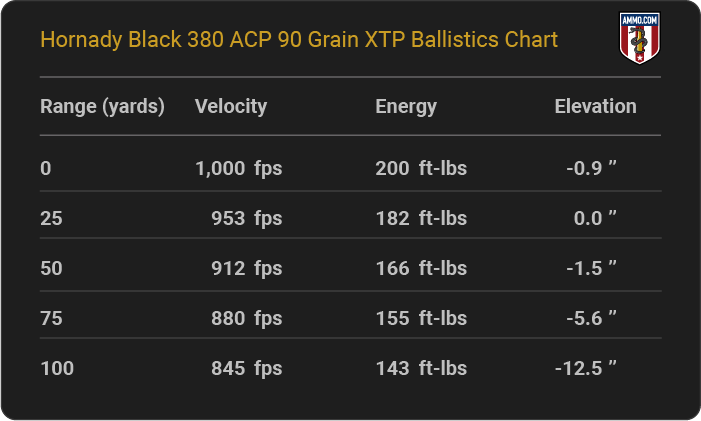
Hornady Critical Defense 380 ACP 90 grain FTX Ballistics Chart
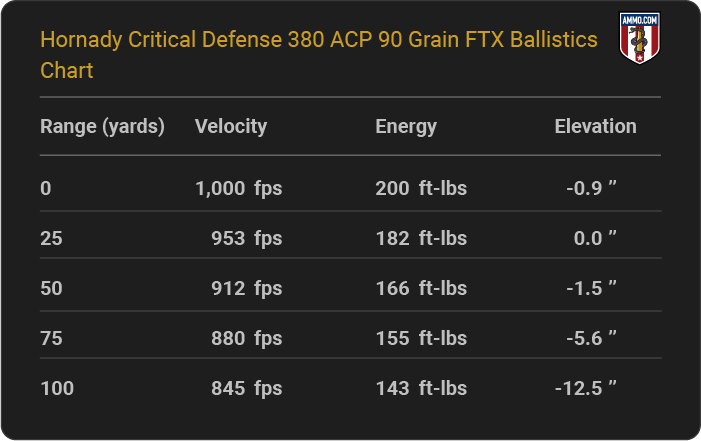
MaxxTech Ammunition Ballistics - 380 ACP
Pobjeda Technology MAXXTech 380 ACP 95 grain FMJ Ballistics Chart

PMC Ammunition Ballistics - 380 ACP
PMC 380 ACP 90 grain FMJ Ballistics Chart
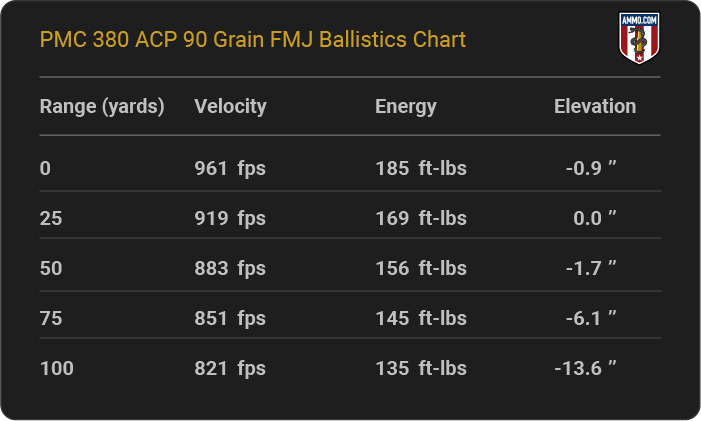
Prvi Partizan (PPU) Ammunition Ballistics - 380 ACP
Jump to a ballistics chart: Prvi Partizan 380 ACP 94 grain FMJ | Prvi Partizan 380 ACP 94 grain JHP
Prvi Partizan 380 ACP 94 grain FMJ Ballistics Chart
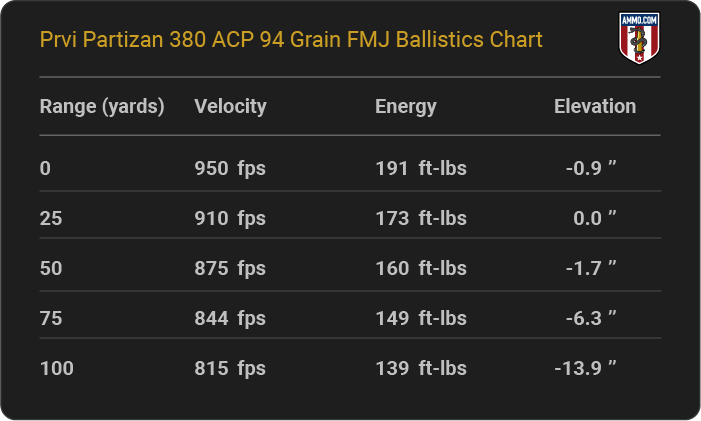
Prvi Partizan 380 ACP 94 grain JHP Ballistics Chart
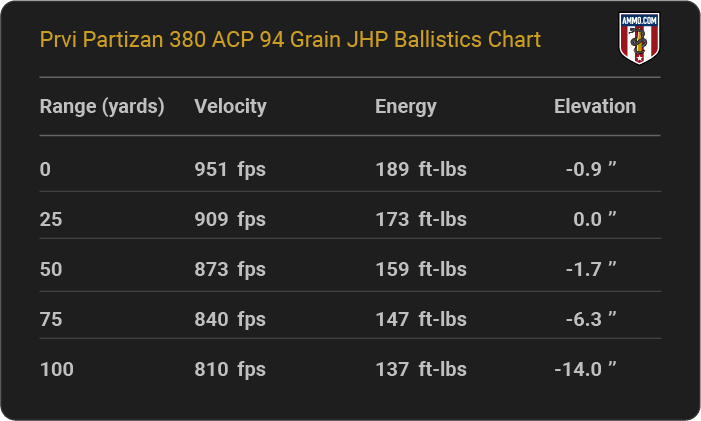
Remington Ammunition Ballistics - 380 ACP
Jump to a ballistics chart: Remington Golden Saber Defense 380 ACP 102 grain BJHP | Remington HTP 380 ACP 88 grain JHP | Remington Range Clean 380 ACP 95 grain FNEB | Remington Ultimate Defense 380 ACP 102 grain JHP | Remington UMC 380 ACP 88 grain JHP | Remington UMC 380 ACP 95 grain FMJ
Remington Golden Saber Defense 380 ACP 102 grain BJHP Ballistics Chart

Remington HTP 380 ACP 88 grain JHP Ballistics Chart
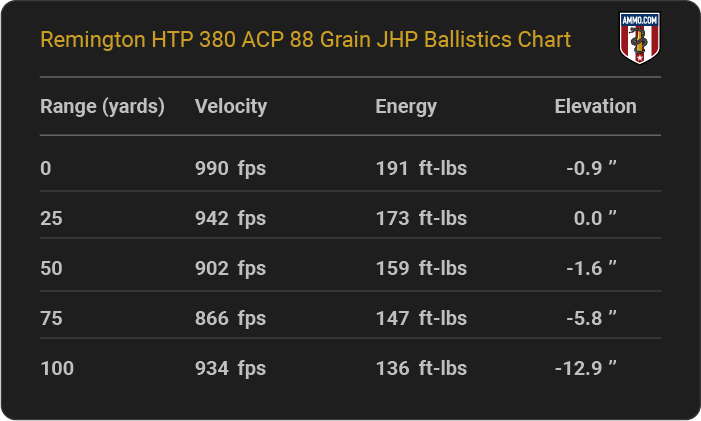
Remington Range Clean 380 ACP 95 grain FNEB Ballistics Chart
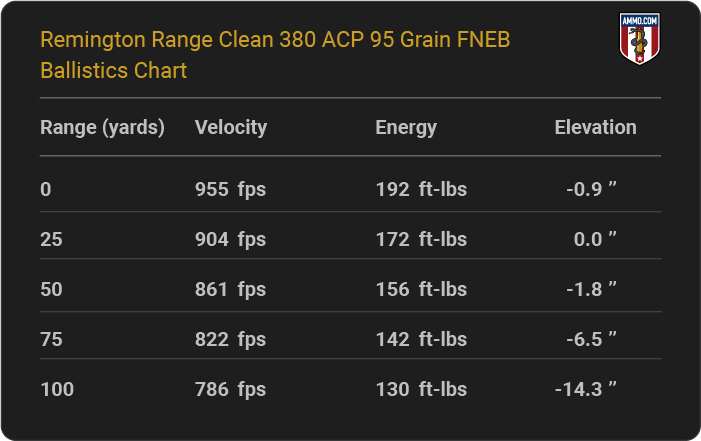
Remington Ultimate Defense 380 ACP 102 grain JHP Ballistics Chart
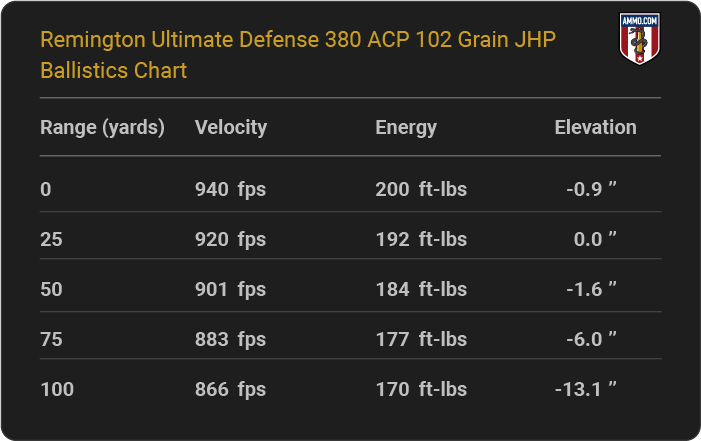
Remington UMC 380 ACP 88 grain JHP Ballistics Chart
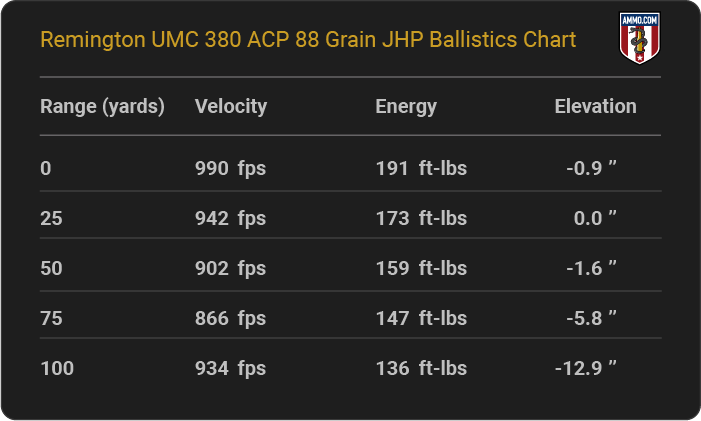
Remington UMC 380 ACP 95 grain FMJ Ballistics Chart

Sellier & Bellot Ammunition Ballistics - 380 ACP
Jump to a ballistics chart: Sellier & Bellot 380 ACP 92 grain FMJ | Sellier & Bellot XRG 380 ACP 77 grain SCHP
Sellier & Bellot 380 ACP 92 grain FMJ Ballistics Chart

Sellier & Bellot XRG 380 ACP 77 grain SCHP Ballistics Chart
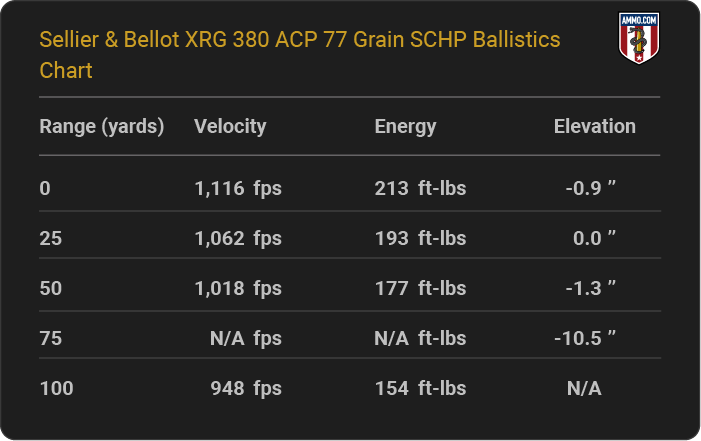
Speer Ammunition Ballistics - 380 ACP
Jump to a ballistics chart: Speer Gold Dot Personal Protection 380 ACP 90 grain GDHP | Speer Lawman 380 ACP 95 grain TMJ
Speer Gold Dot Personal Protection 380 ACP 90 grain GDHP Ballistics Chart
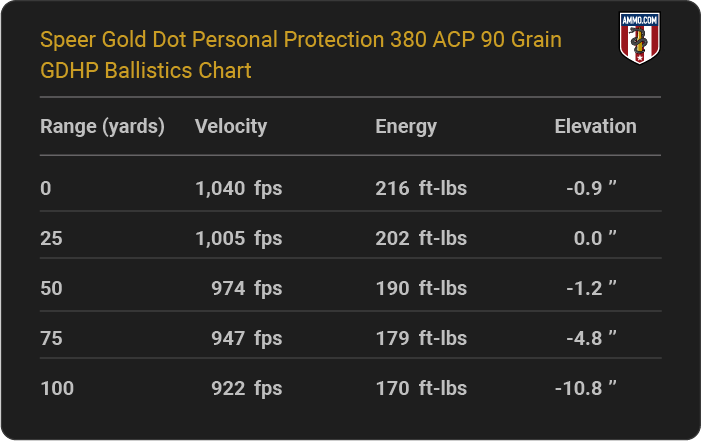
Speer Lawman 380 ACP 95 grain TMJ Ballistics Chart

Winchester Ammunition Ballistics - 380 ACP
Jump to a ballistics chart: Winchester Defender 380 ACP 95 grain BJHP | Winchester Personal Protection 380 ACP 95 grain JHP | Winchester SilverTip 380 ACP 85 grain JHP | Winchester Target & Practice 380 ACP 95 grain FMJ | Winchester WinClean 380 ACP 95 grain Brass Enclosed Base HP
Winchester Defender 380 ACP 95 grain BJHP Ballistics Chart
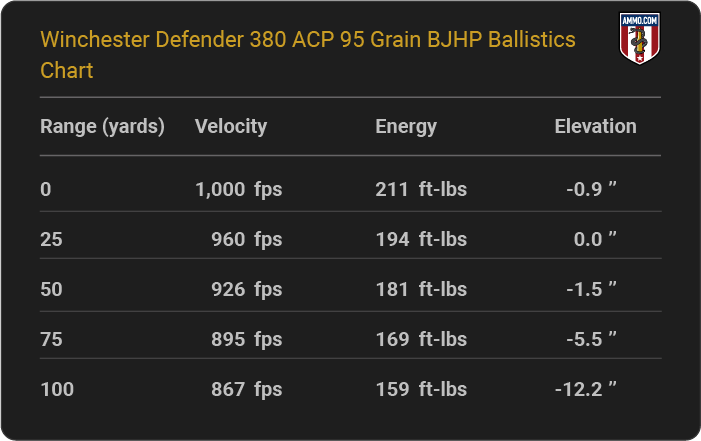
Winchester Personal Protection 380 ACP 95 grain JHP Ballistics Chart
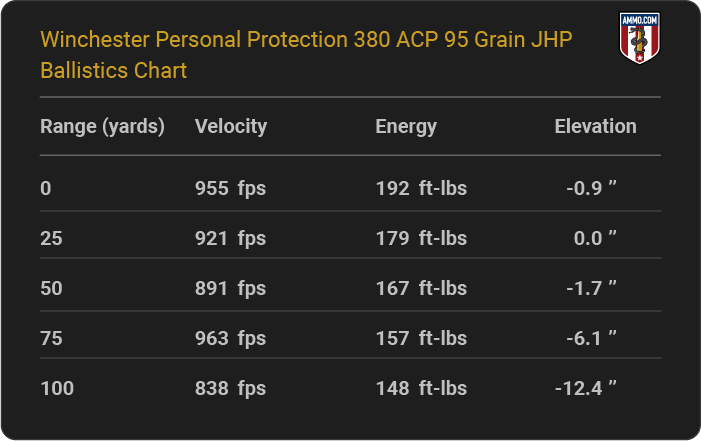
Winchester SilverTip 380 ACP 85 grain JHP Ballistics Chart
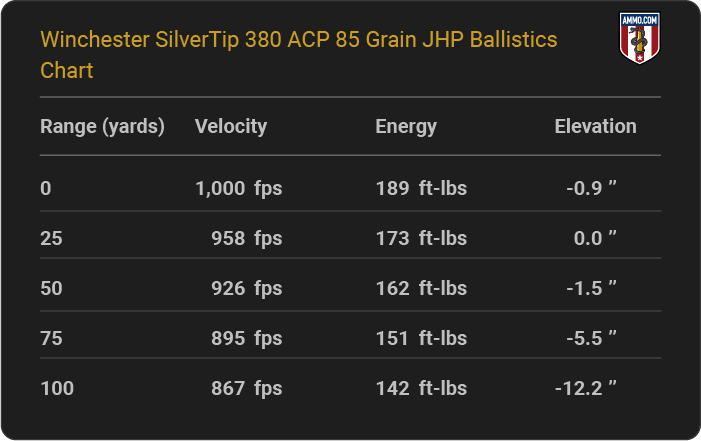
Winchester Target & Practice 380 ACP 95 grain FMJ Ballistics Chart
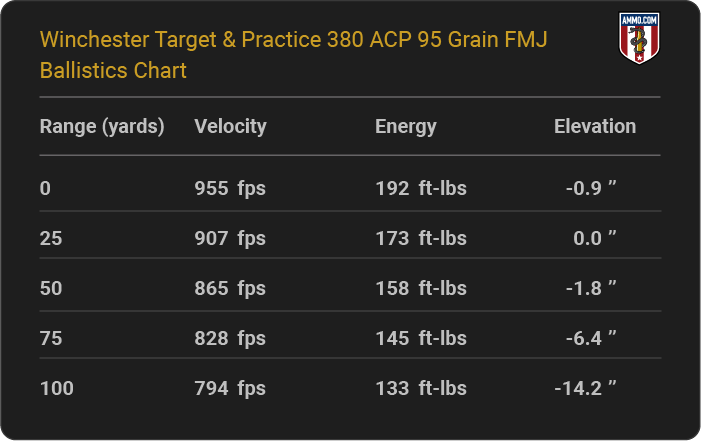
Winchester WinClean 380 ACP 95 grain Brass Enclosed Base HP Ballistics Chart

Administrative Note: The information above comes from the manufacturer and is only informational. The actual ballistics obtained with your firearm can vary considerably from the advertised ballistics. Also, ballistics can vary from lot to lot with the same brand and type load. When manufacturer ballistic data was unavailable, ballistics were calculated using a ballistics calculator.
380 Ballistics Trajectory Chart
A bullet’s flight path is called its trajectory. We measure the trajectory in elevation change through inches of bullet drop, though it can also be measured in minutes of angle (MOA).
A flat trajectory is preferred because the shooter compensates less for bullet drop while aiming. Most handgun cartridges have terrible trajectories compared to rifle cartridges. However, that isn’t really to their detriment, as handguns (and pistol caliber carbines) are intended for firing on relatively close-range targets (within 100 yards), such as during home defense situations.
Below is a sample 380 bullet drop chart that gives you a general idea of the 380 ACP trajectory.
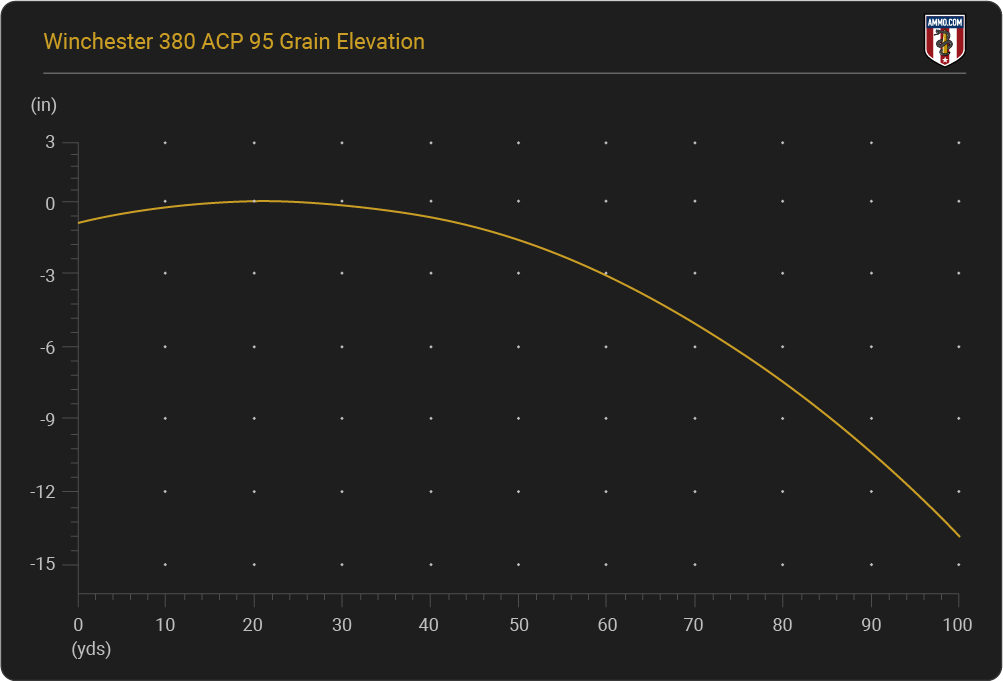
Note: The chart above is an example of one 380 Auto load. Actual ballistic performance may vary depending on bullet weight, lot, barrel length, and environmental conditions while shooting.
380 Velocity
A bullet’s velocity is measured in feet per second (fps). The muzzle velocity is the rate at which the bullet exits the handgun barrel. Generally, a longer barrel produces a higher muzzle velocity, as it gives propellant gasses more time to exert their energy against the bullet. For example, firing a semi-automatic Glock 42 with a 3.25” barrel will produce a higher velocity than firing the same 380 ACP round through a Kel-Tec P3AT with a 2.7” barrel.
Bullet weight and design also factor into a bullet's velocity. Heavier bullets tend to have lower velocities than lighter ones. Bullets with more streamlined profiles, such as a full metal jacket or ballistic-tipped hollow point, tend to conserve more velocity downrange.
When fired from a pocket pistol like the Walther PPK or Ruger LCP, most factory-loaded 380 Automatic Colt Pistol cartridges will have a muzzle velocity ranging from 850 to 1,100 fps.
Dedicated shooters can increase their ammo’s velocities by handloading and reloading. We always recommend following the directions in your reloading manual.
380 Muzzle Energy
A bullet’s kinetic energy is measured in foot-pounds (ft-lbs). Muzzle energy reflects the amount of force with which the bullet exits the pistol’s barrel. Striking energy is the amount of energy the projectile possesses when it collides with its target, such as ballistics gelatin. Only two variables determine a bullet’s energy: its weight, and its velocity at any given instant.
The 380 Auto’s minimal recoil reflects its low muzzle energy. A self-defense round like Blazer Brass 380 ACP 95 grain FMJ only has 188 ft-lbs of muzzle energy. In contrast, Federal American Eagle Indoor Range 45 ACP 137 grain Lead-Free IRT has over twice as much muzzle energy at 438 ft-lbs. The 357 Magnum has even more stopping power with 575 ft-lbs of muzzle energy, and it typically conserves at least 333 ft-lbs of energy out to 100 yards when striking ballistics gel and other targets.
Shot placement is always critical to quickly eliminating a threat during a self-defense situation – especially with the relatively anemic 380 ACP. Ballistics testing shows that it doesn’t perform as well as similar rounds like the 9mm Luger. Still, many shooters love it because of the reduced recoil and ability to effectively use small pistols for concealed carry.
Despite the low energy of the 380 ACP round, many law enforcement officers carry backup pistols chambered for it.
380 Effective Range
The 380 ACP’s relatively low muzzle velocity and lightweight bullets give it a short effective range. (The fact that most 380 ACP pistols have short barrels doesn’t help.) For most shooters, 50 yards will be the maximum distance they should fire across with a 380.
How Do 380 Ballistics Compare to Other Handguns?
The 380 ACP, also known as the 380 Auto, 9mm Short, 9mm Browning, and 9x17mm is a good option for some shooters. Many prefer a firearm chambered for 9mm, 40 S&W, 45 ACP, 357 Sig or 357 Magnum for its superior power.
Let’s see how the 380 Auto stacks up ballistically to similar rounds like the 32 ACP, 38 Special, and 9mm Luger.
380 ACP vs. 9mm Ballistics Chart
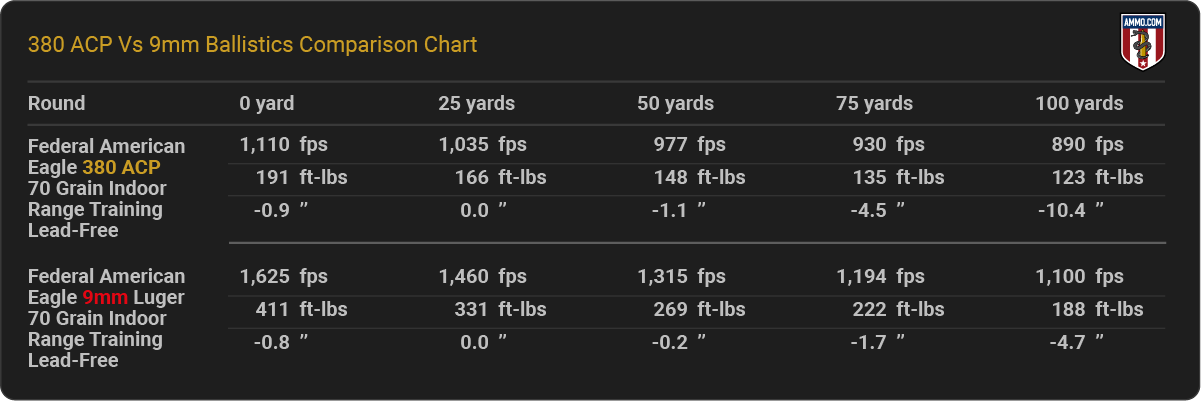
380 Auto vs. 38 Special Ballistics Chart
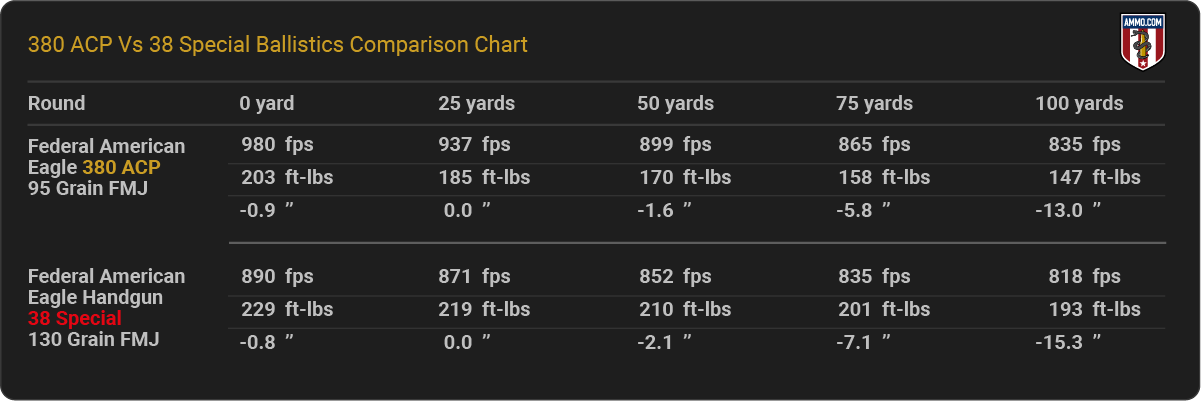
380 vs. 32 Ballistics Chart
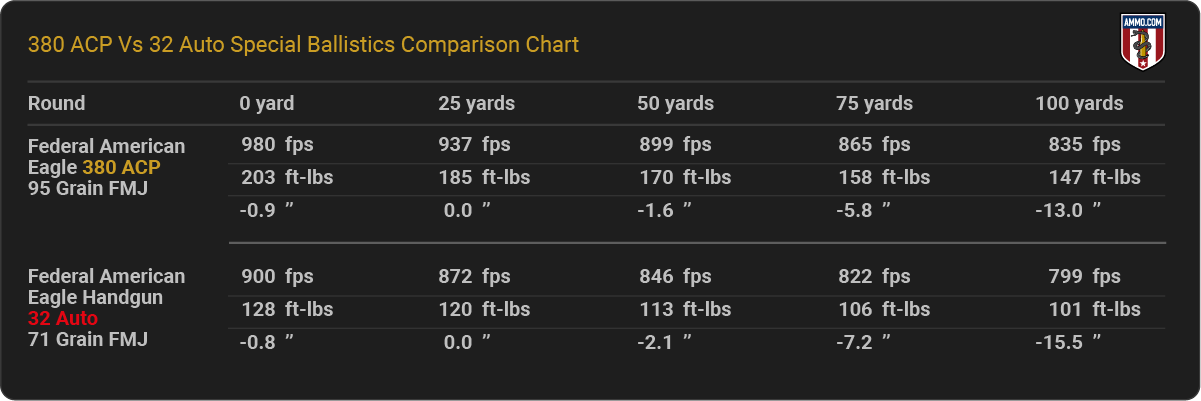
Frequently Asked Questions
Below, the team at Ammo.com has gathered and answered some of the most commonly asked questions regarding 380 ballistics.
At what distance is a 380 effective?
For most shooters, the 380 is only effective within ranges up to 50 yards.
Will a 380 stop an attacker?
Yes, a 380 will stop an attacker at close range.
Is a 380 enough for self-defense?
A 380 is enough for self-defense when the threat is close (10-15 yards and closer).
Is a 380 more lethal than a 22?
Yes, a 380 is more lethal than a 22, although both require excellent shot placement.
Why is the 380 ACP so popular?
The 380 ACP is popular because it has low recoil. Furthermore, most pistols chambered in 380 Auto are easy to conceal.
Ballistic Charts
- 308 Ballistics Charts
- 6mm ARC Ballistic Charts
- 10mm Auto Ballistics Charts
- 224 Valkyrie Ballistics Charts
- 204 Ruger Ballistics Charts
- 30-30 Ballistics Charts
- 6.8 SPC Ballistics Charts
- 350 Legend Ballistics Charts
- 300 Blackout Ballistics Charts
- FN 5.7x28 Ballistic Charts
- 7.62x39 Ballistics Charts
- 22 Creedmoor Ballistics Charts
- 300 PRC Ballistics Charts
- .360 Buckhammer Ballistics Charts
- 8.6 Blackout Ballistics Charts
- 30-06 Ballistics Charts
- 44 Magnum Ballistics Charts
- 7mm-08 Ballistics Charts
- 7mm Rem Mag Ballistics Charts
- 300 Win Mag Ballistics Charts
- 270 Win Ballistics Charts
- 45 Long Colt Ballistics Charts
- 6.5 Creedmoor Ballistics Charts
- 40 S&W Ballistics Charts
- 243 Win Ballistics Charts
- 357 Magnum Ballistics Charts
- 380 ACP Ballistics Charts
- 45 ACP Ballistics Charts
- 223 Rem Ballistics Charts
- 450 Bushmaster Ballistics Charts
- 400 Legend Ballistics Charts
- 5.56 Ballistics Charts
- 9mm Ballistics Charts
- 28 Nosler Ballistics Charts
- 45-70 Ballistics Charts
- 6.5 PRC Ballistics Charts
- 22-250 Ballistics Charts
- 22 Hornet Ballistics Charts
- 7mm PRC Ballistics Charts
- 22 ARC Ballistics Charts
- 6.8 Western Ballistics Charts
